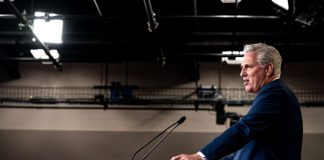JUNE 17, 2020

Charito Morales, shown here in near 5th and Huntingdon Streets, in Philadelphia on Wednesday. Morales puts Spanish-language and English language pamphlets in food boxes to help people navigate COVID-19. – JESSICA GRIFFIN/The Philadelphia Inquirer/TNS
PHILADELPHIA, PENNSYLVANIA – When Charito Morales was passing out pamphlets in North Philadelphia with information on COVID-19 recently, a woman approached her in distress — seeking help with a health problem that, at first, seemed unrelated to the pandemic.
“My daughter is wheezing!” the woman said.
She had tried to call a city health clinic to get asthma medicine for the teenage girl, but was directed to set up a medical appointment through video chat — a big hurdle, as the family lived in a shelter and had no high-speed internet. What’s more, the instructions were in English, and the woman, an immigrant from Guatemala, did not speak the language well.
As with so many other aspects of life during the pandemic, the field of health care has shifted the bulk of its interactions to computer screens and mobile phones — the practice known as telemedicine. It can be an effective substitute for an in-person visit, except when patients lack the necessary technology or have trouble using it.
Struggles like those of the woman from Guatemala are common, said Morales, a volunteer who was handing out the COVID-19 pamphlets on behalf of community groups and the media outlet Kensington Voice.
“What happens to the people who don’t have a computer?” Morales asked. “What happens to the people who don’t have WiFi?”
A new University of Pennsylvania study illustrates the problem in a specialty for which a lack of medical care can have especially grave consequences: cardiology.
In a group of 2,940 patients scheduled for outpatient cardiology visits between March 16 and April 17, those who spoke limited or no English were half as likely as English-speaking patients to “show up” for their video or phone consultation.
Income also appeared to play a role in access to care. People from zip codes with a median household income below $50,000 were half as likely to use video to see the doctor when compared with zip codes with a median income above $100,000. Instead, they opted for a consultation by phone call, said Penn cardiology fellow Lauren A. Eberly, one of the study’s authors.
Older people preferred the phone as well. On average, for every additional year of age, patients were 3% less likely to use video, she said.
Medical appointments via phone call are far better than none at all. But the addition of video may allow physicians and nurses to gain more insight into a patient’s condition, Eberly said. They can see patients’ pill bottles, for example, ensuring that they have an adequate supply and are not taking medicines that might interfere with each other.
And the provider can see if patients have difficulty navigating their home environment, or if they have visible symptoms such as swollen legs — a sign that medicines or diet might need to be adjusted.
“I’ve asked patients to walk around, to see how they feel,” Eberly said.
Patients in the study who did not keep their cardiology appointments were not billed, she said. The clinic, at Penn Medicine’s Perelman Center in West Philadelphia, called them to reschedule.
The study results have prompted a review of procedures to reduce the chance of no-shows.
The clinic already provided translation services during video consultations, but arranging them was a cumbersome, multi-step process that had to be set up in advance, said cardiologist Srinath Adusumalli, the study’s senior author. The center’s tech wizards are developing a new platform that will allow patients to select the appropriate language on the spot, he said.
“We want to reduce any kind of friction,” he said.
In addition, the center is translating instructions on its web site into a variety of languages. For now, the only non-English option is Spanish.
As for those with limited internet access, Penn has applied for funds to help patients obtain broadband coverage, and also is exploring the possibility of installing telemedicine kiosks. These units could be installed at a grocery store or a recreation center, with a curtain or door for privacy, Adusumalli said.
That idea sounded promising to the Rev. Adan Mairena, pastor at West Kensington Ministry, who suggested that another option would be mobile units.
People with lower incomes and minorities tend to be in poorer health in ordinary times, due to a variety of socioeconomic and environmental factors. The added hurdle of telemedicine is sure to make the problem worse, Mairena said.
“I think it’s beautiful that telemedicine exists,” he said. “But it’s another symbol of the digital divide between the haves and the have-nots.”
Morales, the volunteer who was handing out pamphlets, said the Guatemalan immigrant who approached her was on the verge of looking for other asthma patients who could donate their unused medicines.
Not the best idea, said Morales, who is a licensed medical interpreter. A better option, she told the woman, would be to take her daughter’s empty medicine container to a pharmacy and get a refill.
Another helpful tip was contained in the pamphlet itself: instructions on how to apply for Internet Essentials, a low-cost internet service from Comcast.
To the relief of the woman whose daughter had asthma, the instructions were printed in Spanish.
Courtesy/Source: The Philadelphia Inquirer










































































































